Raising the Roof and a Whole Lot More at the Nelson Heritage Center
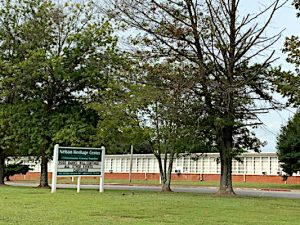
Built in 1960, the Nelson Heritage Center started as an all-black high school until the integration of the current high school. Now as a community center, its supporters also strive to preserve the culture and history of the surrounding ethnic populations.
Every community has a place that serves as its heart. In southern Nelson County, it is the Nelson Heritage Center—and more precisely, its aged gymnasium. When a tenacious group of black community leaders succeeds with an ambitious fundraising plan, the gym will be restored to its former status as the hub of activities in the Heritage Center.
Like a cat with nine lives, the Heritage Center in Arrington, VA, has had a few reincarnations. First erected in 1960 as the county’s all-black high school, it later became the countywide middle school when the current county high school was integrated. After a new middle school was built, the aging facility became simply a warehouse for disused county equipment. It was rescued by the Millennium Group, a nonprofit formed in 2004 to restore the old building and create a community gathering place known as the Nelson Heritage Center.
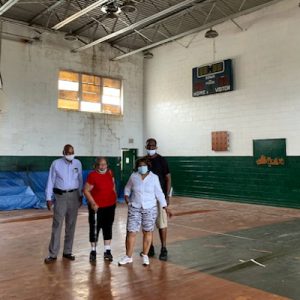
The Millennium Group, standing in the currently condemned gym, is working doggedly to restore it to its former glory so that the young and the old have a healthy outlet for exercise and fun. (L-R) Rev. James Rose, Margaret “Constance” Henderson, Edith Napier, and Rev. Rodney Sandidge.
The gym, too, remained an exercise outlet for youths and seniors, including offering activities through the county’s parks and recreation department. That is, until 2008 when the gym was abruptly closed and condemned due to a long-standing crack in the wall. Already financially stretched, the Millennium Group was required to have an engineering study done, which determined that the gym remains structurally sound, despite the cracked wall and a leaky roof.
“Initially, the whole building was condemned—and we had no warning,” said Edith Napier. But she and other members of the board of the Millennium Group successfully petitioned to allow all but the gym to be reopened for community use. The goal of the Millennium Group has been to use the center to promote education, to preserve the culture and history of the county’s African American population, and to provide services to benefit the community as a whole. “I started school here in the 7th grade in 1960, and I thought it was the most wonderful building in the world,” said Napier.
“This is a historical African American building that was and is vital to the community. But it’s also a place that offers opportunities for people of all age groups. It’s a place where the entire Nelson community can come together.”
She acknowledges, though, that it has been a daunting task to remake the old school into a community center. “When we received the building, it was filled from floor to ceiling with items the county no longer needed,” said Napier. It took a major community effort to empty and clean out the building. The Millennium Group also launched a serious fundraising effort, obtaining grants from area nonprofits such as the Nelson County Community Fund. Inc. and Bama Works.
The center now houses spaces for a cultural center, classes, special events, a commercial kitchen, a computer lab, a charitable clothing and furniture distribution effort, and two food banks. Furniture and food distributions, in particular, have been on the rise with the impact of the Covid-19 pandemic, noted Rev. Rodney Sandidge, another Millennium Group board member and pastor of the nearby St. John’s Baptist Church. “Our big goal now is getting the gym renovated.”
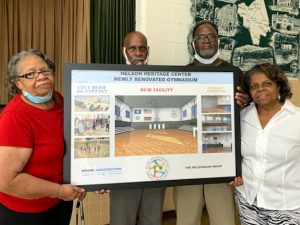
Members of the nonprofit Millennium Group display an architectural rendering of the restoration of the Heritage Center’s aged gym. (L-R) Margaret “Constance” Henderson, Rev. James Rose, Rev. Rodney Sandidge, and Edith Napier.
The push to restore the gym started three years ago when Millennium Group board member Margaret “Constance” Henderson led the charge, staging a series of fun nights and community dinners to raise money. She had heard of some local youths getting into trouble, and “I decided we needed a place for the kids to go,” said Constance. Her focus on youth is natural, given that she once managed the old school cafeteria there. “This building was built for the African American people. It went out of their hands and has come back into their hands, and they are struggling to make it a better place for the youths as well as the seniors.”
The gym is scheduled for a new roof this month (October), but that is just the beginning, said Sandidge. The goal is to raise $200,000 for the gym, including repairs to the old wooden floor in phase two, and a new HVAC system in phase three. “We were getting good at attracting grants until the pandemic started. But the priority now is on food and shelter, and rightly so,” he added. Donations toward the gym restoration can be made by going to the Gofundme link on the Heritage Center’s website.
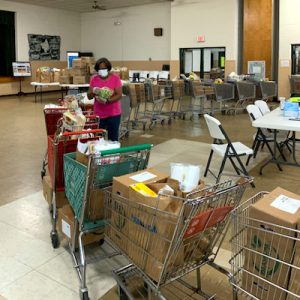
The Nelson Heritage Center supports two community food distributions. The Heritage Center Food Pantry, above, distributes groceries on the third Thursday of the month.
It’s important to remember how widespread the center’s impact is in the community, noted Rev. James Rose of Montreal Baptist Church in Shipman, and another Millennium Group board member.
To that end, the center has been broadening its community services. It created space for a child care center that was to open, before plans fell through due to the pandemic. Now, the Millennium Group is working to bring the Virginia Health Department’s facilities, including a clinic and environment health office, to the center, once its lease is up at the Blue Ridge Medical Center. “It would anchor the center to house the health department,” said Napier. “We think it would benefit the community to have something like this in the west district and southern part of Nelson County,” added Sandidge. “We’ve done a lot of the legwork already, including contractor and architectural evaluations.”
“There’s a lot of opportunities here [at the center], and with the community’s help, we can get everything taken care of—inside and out.”
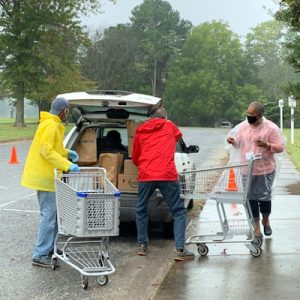
The Blue Ridge Mobile Food Pantry stages a drive-through grocery distribution on the first Tuesday of the month. Both have seen increased demand due to the Covid-19 pandemic.
What has made the Nelson Heritage Center most successful to date are the hundreds of thousands of hours put in by volunteers to restore and maintain it. “We all wear several hats,” said Sandidge, who joked that he also doubles as the center’s custodian. “I think the future of the community center, once the gym is open, will be to bring back our youth and also our older people, where they can once again have fellowship with one another.”
Nelson County Community Fund, Inc., board member Sue Klett interviewed Millennium Group board members recently for this article on restoration efforts for the Nelson Heritage Center. More photos of the restoration work on the center’s community gym appeared in the December 2020 #189 issue of Blue Ridge Life magazine. NCCF has made grants to support both the center’s gym restoration and the Heritage Center Food Pantry.
For information on NCCF and to make a donation go to www.nelsonfund.org
Click this link to read other interviews with other beneficiaries of the NCCF.
No Child Need Go Hungry on
Nelson Kid Care’s Watch

Nancy Tapager (L), widow of Nelson Kid Care founding director Mike Tapager, and program co-director Rev. Marion Kanour share lots of laughs as they encourage volunteers to keep up Mike’s legacy of providing food to carry hungry school children through weekends.
NCCF board members Sue Klett and Ken Heise recently visited with Nelson Kid Care volunteers to find out what motivates them to tackle child hunger head on in the county. Nelson Kid Care has received grants from NCCF to support its mission, and a number of NCCF’s donors also volunteer with the program.
In a cavernous warehouse, half a dozen retirees move rapidly down a line, plucking small food items to pack in a plastic grocery bag. They bundle the bags into the back of an SUV at the end of the row. Once filled, the SUV takes off to deliver its cargo to area public schools, where the food bundles are distributed quietly and anonymously to children. For some, the food parcels may be the only sustenance they receive over the weekend. The cans of pasta, peanut butter crackers, apple sauce and such may carry the children (and siblings with whom they share) through to their next fresh meal from the weekday school free meals program.
Like clockwork this process repeats for two shifts every Thursday at the commercial food warehouse of Blue Dog Associates in Lovingston. A matching scene unfolds weekly at Rockfish Presbyterian Church in Nellysford. For nine years it’s been the mission of Nelson Kid Care. The program was an outgrowth of a Lenten study group on poverty undertaken by area Episcopal churches.
“We have the best volunteers in the world. It’s a testament to Mike’s legacy,” said his widow, Nancy Tapager
Founding director Mike Tapager oversaw Nelson Kid Care until his untimely death in 2018. Carrying on as co-directors in his memory are his daughter, Katie Hughes, and Rev. Marion Kanour of Grace Episcopal Church in Massies Mill. The all-volunteer program operates under Amherst-Nelson Cares, Ltd., a non-profit 501(c)(3) charitable organization that helps keep administrative costs to down around 2 percent of Nelson Kid Care’s $40,000 annual budget. The program struggled financially in the year after Tapager died, when fund raising was suspended until the program’s administration could regroup, said Kanour. “At one point we were $20,000 short, but we’ve turned the corner on that deficit.”
Churches, businesses/individuals, and other community non-profits each supply about one-third of the funding for Nelson Kid Care. In addition to receiving a grant from NCCF, the nonprofit endowment board of Emmanuel Episcopal Church continues to provide grant funding. Nelson Kid Care also partners with local businesses who adopt it as a nonprofit organization, in exchange for voluntary help at business events. “Our goal is to be fully community sustainable,” said Kanour. “In part, that means we’d really like a business or a consortium of businesses to commit to regularly funding a portion of our budget. Or a really large donor or an endowment would be nice!”

Nelson Kid Care volunteers (L-R) Barbara Heyl, Poppet Nelson, Nancy Tapager, and Virgil Elbrecht make short work of stuffing sacks of supplemental weekend meals for needy public school students every week throughout the school year.
The driving force behind Nelson Kid Care is a large, committed volunteer pool of about 140 persons (mostly retirees) who purchase, stuff, and deliver meals to schools. “We have the best volunteers in the world. It’s a testament to Mike’s legacy,” said his widow, Nancy Tapager. Through careful negotiating and purchasing, the program has been able to keep the per child cost per bag to $4-$5 to serve as many children as have been referred. Nonetheless, the program has had to scale back meals—by dropping the fruit drink or Gatorade—to keep the meals affordable. Blue Dog Associates, a commercial food supplier to elder care agencies, sells food items at cost to Nelson Kid Care, and donates warehouse space for packing student meals. Other food is purchased at area big box stores.
“If [the kids] come, we’ll feed them. It’s like the loaves and the fishes, only we supply ravioli and granola bars,” assured co-director Kanour.”
Nelson Kid Care estimates it is serving approximately 27 percent (255 persons) of the free lunch eligible student population. Although all four Nelson County Public Schools participate during the school year, most recipients are elementary school aged. The program is dependent on referrals made by school officials. But Kanour admits a more consistent recipient identification and referral process would help increase program participation.
Another challenge has been making the meals more nutritionally balanced. The meals are meant to supplement other foods, and have to be “shelf stable” in case they get left behind on a bus or in a locker. Also, since most recipients are young children, the meals must be ready to eat, without much preparation required, Kanour noted. That means fresh items, other than the occasional apple, are not included.
Could Nelson Kid Care serve even more students with weekend meals? “If they come, we’ll feed them. It’s like the loaves and the fishes, only we supply ravioli and granola bars,” assured Kanour with her trademark grin.
Pursuing College 101
Note: A shorter version of this interview appears in Blue Ridge Life Magazine’s July 2019 issue, page 37, and in the magazine’s online version. We thank BRL’s publishers, Yvette and Tommy Stafford, for helping NCCF publicize our success stories.

If you had asked 18-year-old Nelson County native Adrieanna Vest-Turner back in middle school what career she wanted to pursue in college, she might have sighed and said college was not in her future. However, thanks to encouragement from her family, plus mentoring and financial support from a nonprofit-supported college preparatory program, Vest-Turner just completed her freshman year at Mary Baldwin University. She credits her success, in part, to Project Discovery, a scholarship program for Nelson County High School (NCHS) students offered by the Monticello Area Community Action Agency (MACAA). Project Discovery receives grant funding from the non-profit Nelson County Community Fund (NCCF). As she sat down to chat about her college quest with BRL, it was clear, too, that her strong personal drive is a factor in achieving her dreams.
BRL: What drew you to Project Discovery, and how did the program help you?
V-T: My older sister (Aja) was in the program, and she kept on me to get involved and take advantage of all it offered. I started with the GRASP program in 10th grade (which donated $500 per year towards a student’s college education). That program led to Project Discovery in my senior year. My mom, too, encouraged me, saying that if I wanted to go to college I needed to find ways to do it. She’s a single parent and couldn’t take the time off to help me look at schools. Through Project Discovery, I was able to explore college options, and go on tours. I also got help prepping for the SATs and ACTS, and filling out college applications and financial aid forms. Plus, I received a $3,000 scholarship through MACAA.
BRL: How did you land on physical therapy as a major?
V-T: I come from a pretty athletic family, and I played volleyball and ran track at NCHS. I started out wanting to be an athletic trainer. The mentors I met (Jane Francis, NCHS GRASP coordinator, and Katelyn Hebel, NCHS college advisor) talked me into physical therapy because you can do more with it as a career. With a physical therapy degree, I could be an exercise physiologist, or a personal trainer, as well as a therapist.
BRL: How did you decide on Mary Baldwin?
V-T: Katelyn (college advisor) helped me a lot—she urged me to apply everywhere! I applied to 13 schools with the waivers I was able to get through Project Discovery. We compared all the aid packages, and I went where I could get the most financial help so I wasn’t saddled long-term with loans. Mary Baldwin also wanted me for volleyball which helped me find academic scholarships.
BRL: What was your first year like at college?
V-T: I had a hard time adjusting at first; I didn’t feel like I fit in. But then being on the volleyball team has help a lot. Also, I joined the Ida B. Wells Society, an African-American leadership program named for the Black abolitionist and investigative journalist who used her platform to reach out to Black women in her community. All that has helped me find a niche and I feel I belong a there (at Mary Baldwin) now.
BRL: Are you continuing with school this summer?
V-T: Actually, I’m off for the summer—to make money for school! I’m working again at the ACAC’s “Adventure Central” preschool and summer camp, where I started last summer as a counselor.
BRL: You have a lot of energy! What would you say to others like you who are good students and might consider pursuing a college education—but are not sure they can swing it?
V-T: You have to work at it. Some who started Project Discovery with me dropped out. I’d say if you want something bad enough, go for it. Don’t think that it matters where you came from, or how well-off your family is—because it doesn’t. I grew up not thinking that I would go to college, but God made a way—and I followed it.
Contributed by Sue Klett, a member of board of the nonprofit Nelson County Community Fund, Inc. NCCF makes grants to local nonprofits meeting the educational and humanitarian needs of Nelson County residents.
Dollars Well Spent: How Grants Fulfill Teachers’ Wish Lists
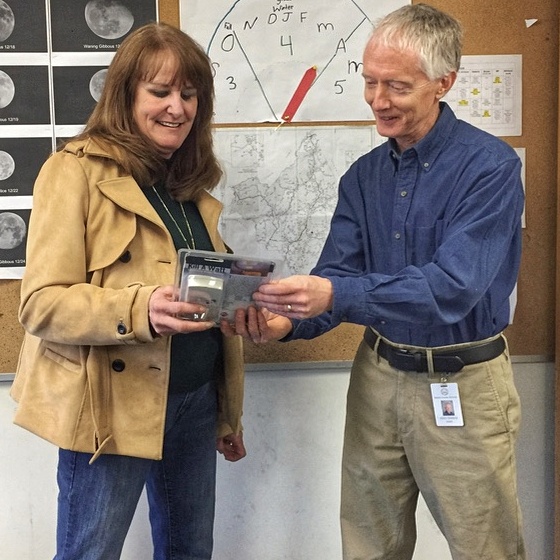 Kathie Driscoll (left), Education Director for The Nature Foundation at Wintergreen, presents Rockfish Elementary School science teacher Allen Dolleris with a “Kill-O-Watt” voltage meter for his students to learn about energy usage. NCCF gave the nature foundation a grant to help fund teaching materials.
Kathie Driscoll (left), Education Director for The Nature Foundation at Wintergreen, presents Rockfish Elementary School science teacher Allen Dolleris with a “Kill-O-Watt” voltage meter for his students to learn about energy usage. NCCF gave the nature foundation a grant to help fund teaching materials.
Ask teachers what they love about teaching and they likely will say it is “watching a light bulb go off” in a student’s expression, which means the child has made a connection between a classroom exercise and real life. That is what drives 4th grade science teacher Allen Dolleris to get creative with classroom projects that both turn on his students, and ensure that the skills they learn will stick with them. Grants for purchase of classroom materials that Dolleris and other Nelson County Public Schools science teachers receive through The Nature Foundation at Wintergreen are a huge help. The Nature Foundation, in turn, receives a portion of its funding for teacher “wish lists” through grants from the Nelson County Community Fund (NCCF). Nelson County Advisory Committee member, Sue Klett, chatted recently with Dolleris about how he uses his “wish list” contributions to further students’ understanding of the role of science in their lives.
NCCF: How did you end up teaching at Rockfish Elementary for 18 years?
Dolleris: I majored in engineering at Bucknell University. Then I spent a lot of time teaching math and English in international schools overseas in places like Japan, Ecuador, and Morocco. I was teaching in Japan when a position opened up for a 5th grade science teacher at Rockfish Elementary. It was sort of a calling for me—I was socially miserable as a 4th and 5th grade student and I wanted to help kids at this age.
NCCF: What challenges have you seen as a teacher in Nelson County?
Dolleris: I bring engineering into teaching big time. I’m not so much an educator as an engineer. I build stuff. For instance, I build a connection between what we [the students] are doing with electrical currents and what happens under the hood of a car.
NCCF: So you “make it real” for students.
Dolleris: I try. My dad taught me how to fix things, how to make things last past their normal service life. He said, “Make it work and make it work well.” Still, he wasn’t a “green” [i.e., ecology-minded] guy like I am.
NCCF: What is an example of an item you’ve received with your wish list grants, and how have you used it in the classroom?
Dolleris: One big purchase was for 10 “Snap Circuits Jr.” kits that cost around $35 each. The circuit board kits are a huge time saver in teaching about electrical currents. Plus, the skills kids learn can be directly related to how electricity runs in a house, or an electric car, or even an integrated circuit, like a cell phone.
NCCF: Virginia Standards of Learning (SOL) requirements are said to loom large in teachers’ lesson plans these days. What’s an example of how you are addressing SOLs with your wish list projects?
Dolleris: Last year, I requested 10 anemometers to teach students how to measure wind speed. One of the SOL strands relates to weather and selecting tools for measuring. I used the anemometers to teach students two scales, metric (meters per second) and customary (feet per second). They had a blast figuring out how fast the air comes out of the huge fan in the gym, which was developed into a major project using the scientific method.
NCCF: What will you do with the “Kill-A-Watt” voltage meter that you received as this year’s wish list item?
Dolleris: The “Kill-A-Watt” measures total electricity use over time in kilowatt-hours. You plug it into the wall socket, then plug an appliance into it to see how much energy it [the appliance] draws over time. My class project will be to have students see what appliances around the school are costing to operate. They’ll find that operating a vending machine is off the charts. But other items are amazingly efficient. The beauty of a Chromebook [student-issued laptop] is that it only pulls 11 watts of energy and it shuts off when you close it.
NCCF: All things being equal, what else would you put on your school wish list if you could?
Dolleris: More time to teach, and a classroom aide to help with labs. Science class is a 40-minute block with no extra time for labs. I have 60 students to teach. Kids get going [in a lab] and you can’t get them out the door. The boys love it—and girls, too. I’m determined to give girls the same amount of attention to teach them how to fix things.
NCCF: So what are you plans for Spring Break?
Dolleris: Build things! I also have a long fix-it list
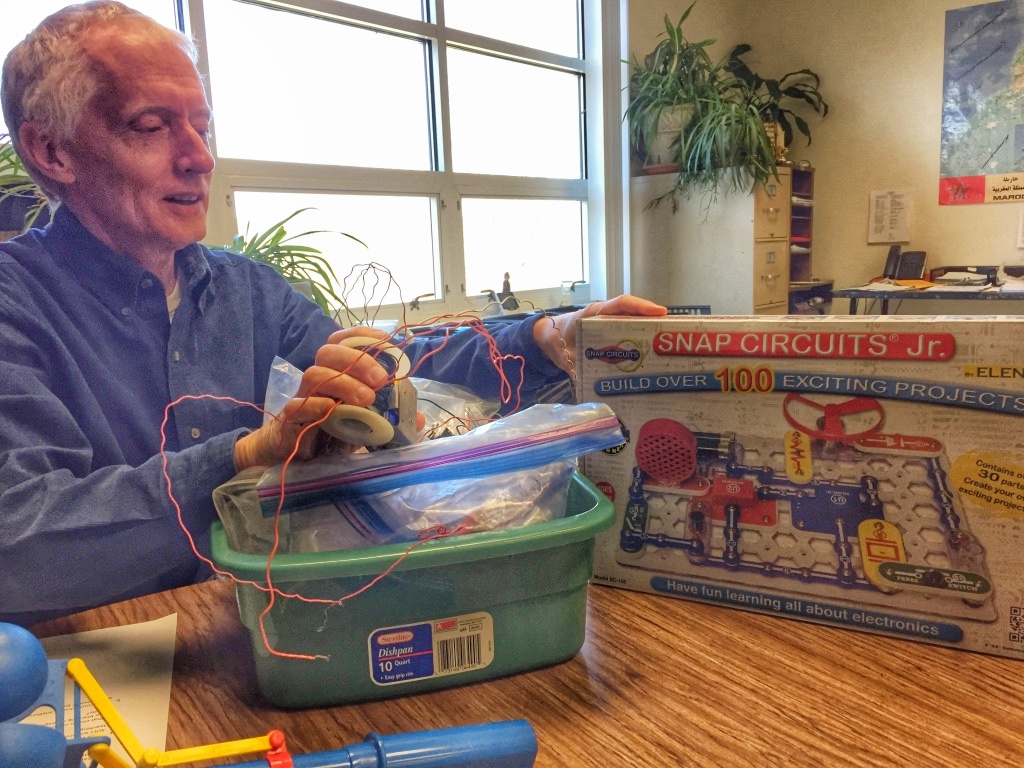 Rockfish Elementary School science teacher Allen Dolleris says the donation of a circuitry kit (right) instead of a tub of wiring supplies saves him much needed time in class labs to teach students about electric currents.
Rockfish Elementary School science teacher Allen Dolleris says the donation of a circuitry kit (right) instead of a tub of wiring supplies saves him much needed time in class labs to teach students about electric currents.

Sue Hess (L) and Heather Kellams are firm believers in the power of healing and hope provided to GHH residents.
Healing from within at Georgia’s Healing House
A middle-aged grandmother, a dynamic social worker, a physician—what do they all have in common? Each is battling addiction. Each has found safety, support, and most of all—hope—inside the doors of Georgia’s Healing House.
Started in 2015, Georgia’s Healing House (GHH)* is a residential haven for women in early recovery from drug and alcohol addiction. The stately Victorian house in Charlottesville accommodates up to 12 women at a time as they journey through treatment and therapy. The women are referred from the Region 10 catchment area, which includes Nelson County. The Nelson County Community Fund has awarded grants in support of GHH since its inception.
GHH Executive Director Sue Hess, and two of its residents, Heather Kellams, who handles marketing and fundraising/grant writing, and Deborah (Debbie) Arrington, sat down recently with Nelson County Advisory Committee member Sue Klett to describe life at the all-women’s residence.
Q: Debbie, you mentioned that you grew up in Nelson County. What was the path that led you down the road to an addiction to alcohol?
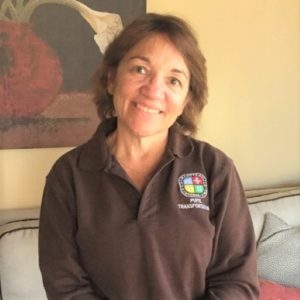
Nelson County native Debbie Arrington credits GHH with helping her restore her life, her job, and most importantly, her relationships with family.
Debbie: My great-grandma’s house was where Afton Vineyards now stands, and my grandparents’ house is nearby. I grew up in a family with a huge history of alcoholism and tragedy. But I never drank much growing up. Then in 2002, I had gastric bypass surgery. The doctor warned me not to drink because if I did I could become an alcoholic [more easily]. That’s exactly what happened.
Q: You said you were in and out of addiction treatment programs for many years and in four different states. How did you come to live now at GHH? What were you looking for when you moved in here a year ago?
Debbie: I lost my house, my car, my job. It [addiction]cost me my marriage and my self-respect. Because of all that’s gone on in my life, my relationship with my daughter has been hard. She had even paid for me to go to treatment in Pennsylvania. But my grandsons are my life. One just turned 13 the other is 15 months old. I moved back [to Virginia] so I could be close by to see them. My daughter didn’t want me around them because of my drinking. Moving into GHH has kept me accountable. If I wasn’t living here, I’d probably be drinking and without a job, and maybe even dead. I have a roof over my head and peace at night, so I don’t need to drink. Even if I did move out, I would not want to be alone. I want a safety net.
Sue H.: Our motto is “recover, grow, flourish.” Debbie’s now in the grow and flourish phase. Besides attending treatment and therapy sessions, she drives a bus for Charlottesville city schools and attends PVCC (Piedmont Valley Community College) classes for information technology and business management.
Q: Aside from a sisterhood of women battling addiction, what sort of supports does GHH offer?
Sue H.: I’m a psychiatric nurse. It was a cocaine addict who inspired me to get involved with GHH. She said she needed a place to “just be,” a place where she could heal. When women first come to us they are in the “recovery (healing) stage,” the first one or two months. We don’t pressure them to have a job or worry about finances—just that they go to public/private therapy and support classes [offered throughout the community]. But there is structure so they can learn how to manage their lives again. Everyone has to be up by 8 a.m. (9.a.m. on weekends), then out at a job, or community service, or classes or something meaningful. There are group meals on Sundays and Thursdays when we check in on each other’s highs and lows of the week, discuss getting chores done, and so on. We also have random room checks and drug testing. Holidays are hard to get through, so we try to offer extra support over the holidays.
Q.: You say the average stay for a resident is 6 to 18 months. Heather, you are going on two years at GHH and are now on staff. What has the program done for you? As a former social worker, how are you giving back?
Heather: My favorite motto is “hope heals.” Instead of being defined by our addiction, here we teach women day-to-day how to live with their addiction. To see yourself not as an alcoholic but as someone who is able to manage yourself and your life. I started “Women for Sobriety” meetings in which our residents convene every Sunday night to rethink our habits and behavior to work toward positive outcomes. Research shows that women addicts need a separate healing program from men because women have so much more shame. Women for Sobriety is a recovery model that helps women focus on their strengths and is hope-oriented. You don’t look at the damaged life behind, you look out the front door to where you are going.
Sue H.: As long as women are setting appropriate goals and moving forward, they can stay here.
Q.: The media is full of stories about the opioid crisis, especially in rural areas. Has GHH seen an uptick in residents with opioid-related addictions?
Heather: Yes, we started with mostly alcohol-addicted residents. Now half of our residents are battling drug addictions, including opioids.
Q.: Do you think there is anything about living in a largely rural environment, in particular, that contributes to the growing addiction problem?
Debbie: It’s the isolation. Young people are bored; they’ve got nothing to do. What I’d say to a rural addict is not to isolate yourself, get yourself out [of your situation]. Get out and help other people.
Q.: What can you advise young women about not falling into the trap of becoming addicted?
Debbie: I’d like to see young women stay in school. I’d tell them just because your friends are doing something, if you are not comfortable doing it, don’t do it.
Sue H.: It’s also a trend with rural addicts that they want to come in and get treatment and heal, but they can’t because so many are caregivers in their family and they are needed at home. We also need to get people into treatment—not jail. Many addicts suffer from a cycle of mental health problems, trauma, and addiction. Jail does not help break that cycle.
Q.: What’s at the top of your wish list for GHH?
Sue: A step-down house where people like Debbie can go that offers more freedom and responsibility, but where you do not have to live alone. We need affordable rental property where women can pay more of their expenses as they become able.
Q: Thank you, and keep up your wonderful work.
*The non-profit Georgia’s Healing House is named for Georgia Barbour, a professional photographer and former Peace Corps volunteer who died from alcoholism, in part because she had no place to heal. For more information Georgia’s Healing House and to find out about its tea party fundraisers, visit www.georgiasfriendscville.org.
